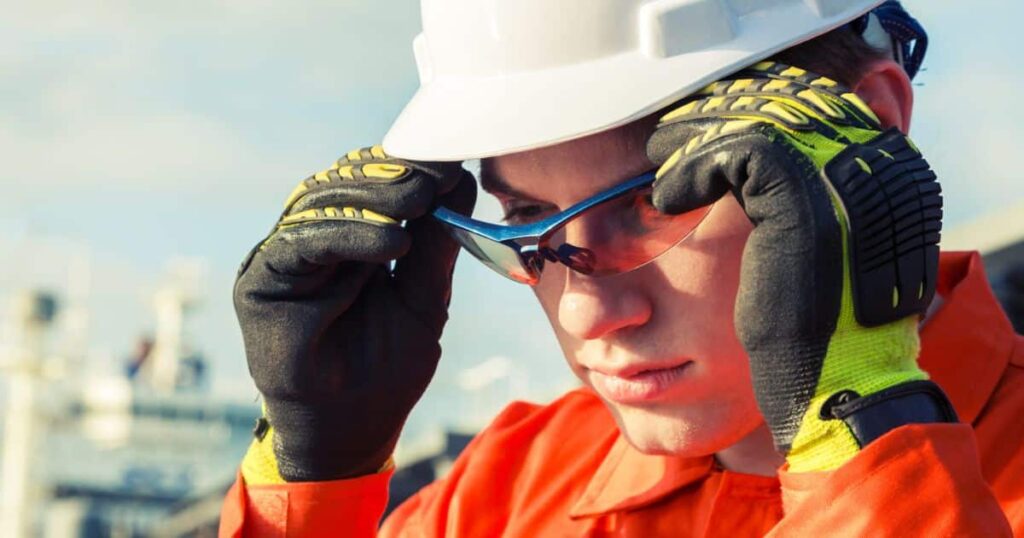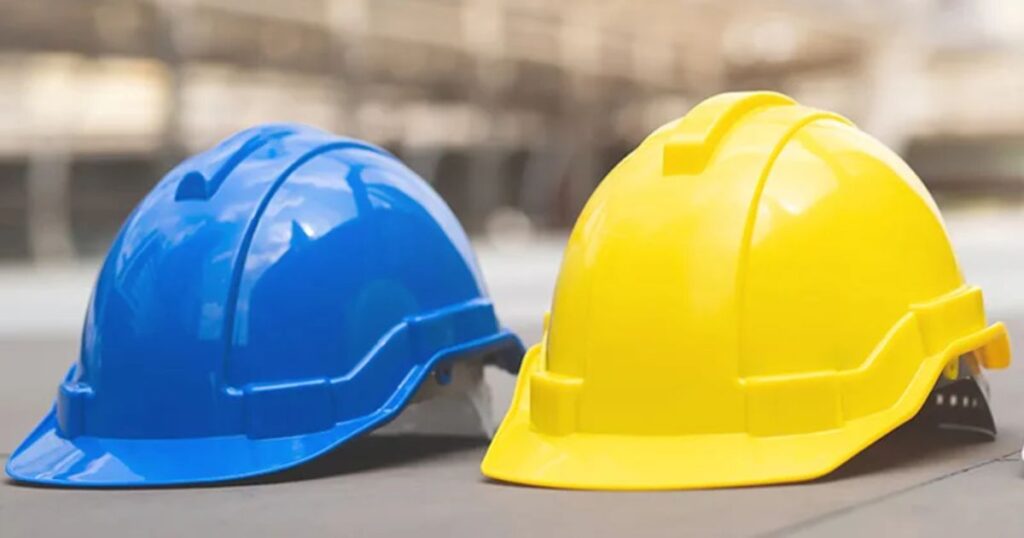Wearing the proper class of hard hat is crucial for preventing serious head injuries at work. Class G offers basic protection, Class E guards against electrical hazards up to 20,000V, and Class C is conductive. Inspect hard hats regularly and replace after significant impacts or every 5 years.
Avoid jewelry, tie back hair, and wear PPE like safety goggles when needed. If injured due to lack of proper headgear, you may have a case for compensation. Choose and maintain the right hard hat to stay safe on the job.
This comprehensive guide will cover the different hard hat classes, when each type is required, and other important safety considerations.
What Class of Hard Hat Do You Need for Minor Bumps at Work?
Classes of Hard Hats
There are three main classes of hard hats, each designed to provide different levels of protection:
- Class G (General): These hard hats offer impact and penetration resistance from falling objects, providing basic protection for the head. This is the most common class used in construction and other industrial settings.
- Class E (Electrical): In addition to the protection of a Class G hard hat, Class E hard hats are designed to protect against high voltage shocks and burns. They are made of non-conductive plastic and can withstand up to 20,000 volts of electrical current. Class E hard hats are essential for workers like electricians, utility workers, and anyone who may come into contact with live electrical components.
- Class C (Conductive): Unlike the other two classes, Class C hard hats are actually designed to conduct electricity. They offer no protection against electrical hazards but can help vent away lightweight bumps and brushes. These hard hats are less common and should never be worn around electrical equipment or wiring.
Importance of Wearing the Correct Hard Hat
Choosing the right class of hard hat is incredibly important for preventing serious head injuries on the job. Wearing the wrong type of head protection, or none at all, can have devastating consequences.
“Head injuries are among the most common and serious injuries sustained by construction workers. Wearing the appropriate class of hard hat can literally mean the difference between life and death.” – John Doe, Safety Consultant
By wearing a hard hat that meets OSHA and ANSI safety standards, and is properly fitted, you can dramatically reduce the risk of traumatic brain injuries, skull fractures, and other potentially life-altering harm.
Jewelry in the Workplace

In addition to the hard hat itself, there are other safety precautions to take into account. Wearing jewelry like rings or necklaces on the job site is generally not recommended, as these items can conduct electricity and lead to shocks or burns. Long hair should also be tied back to prevent it from getting caught in machinery.
Loose clothing is another hazard to avoid, as it can easily get snagged on equipment and potentially pull you into harm’s way. Always dress appropriately for the work environment.
Features of Class E Hard Hats
Class E hard hats are designed with special features to protect against electrical dangers:
- Non-Conductive Plastic Shell: Prevents the wearer from becoming a conductor of electricity.
- Up to 20,000V Protection: Can withstand extremely high voltages without passing the current through to the head.
- Suitable for Electricians, Utility Workers, etc. Intended for those who routinely work around live wires, panels, transformers and other electrical components.
Which Class Of Hard Hats Will Protect You From Electrical Shock?
Only Class E hard hats are designed to protect against electrical shocks and burns. The non-conductive plastic shell prevents the wearer from becoming a conductor of electricity in case of accidental contact with live wires or components. Class E hard hats can withstand up to 20,000 volts without allowing the current to pass through to the head.
Class G and Class C hard hats do not provide any protection against electrical hazards. Wearing them in environments with electrical risks can lead to severe shocks, burns, or even electrocution.
Read More:
Notti Osama Age, Bio, Net Worth, Lifestyle
What Should You Consider When Choosing The Type Of Full-Body Protection You Use?
When selecting full-body protection like coveralls or protective suits, there are a few key factors to consider:
- Hazards Present: Identify what specific hazards the protection needs to guard against (heat, chemicals, electricity, etc.)
- Level of Protection Required: Determine if you need basic protection or more robust shielding based on hazard levels.
- Mobility/Comfort: Choose protective gear that allows for sufficient movement and breathability while working.
- Proper Fit: Ensure the full-body protection fits snugly without restricting motion or creating tripping hazards.
- Compatibility with Other PPE: Make sure the suit/coveralls can be properly worn with other required PPE like hard hats, respirators, etc.
The more hazardous the work environment, the more comprehensive and rugged the full-body protection needs to be. Always refer to safety guidelines for your specific industry and situation.
What Should You Consider When Choosing The Type Of Eye Protection You Use?

Selecting the proper eye protection is critical for preventing workplace eye injuries from flying debris, chemical splashes, or radiation exposure.
Factors to consider include:
- Work Activities: The eye hazards present for your specific tasks (impact, heat, chemicals, etc.)
- Proper Fit: Eye protection that fits snugly without obstructing vision.
- Anti-Fog Capabilities: Lenses designed to prevent fogging up in warm/humid conditions.
- Impact Resistance: Safety glasses or goggles rated for high impact if needed.
- Ultraviolet Protection: Lenses that block 99.9% of UV rays for outdoor work.
- Special Features: Venting, anti-scratch coatings, prescription lens inserts, etc.
Never settle for subpar eye protection. Quality safety glasses or goggles can prevent devastating and irreversible eye damage.
If Full Body Protection Is Needed In Your Job, Whose Responsibility Is It To Pay For It?
According to the Occupational Safety and Health Administration (OSHA), employers are responsible for providing all required personal protective equipment (PPE) to employees free of charge when it is needed to safely perform their job duties.
This includes providing appropriate full-body protection like:
- Fire-resistant jackets/pants
- Chemical aprons/coveralls
- Insulated suits for heat protection
- Cut-resistant sleeves and aprons
Employers cannot require employees to pay for their own PPE, nor can they implement policies that discourage or impede proper PPE usage. Maintaining a safe work environment through providing essential protective gear is solely the employer’s fiscal responsibility.
What Type Of Eye Protection Should You Use When There Is Dust Present?
When working in dusty conditions, safety goggles are the recommended form of eye protection rather than standard safety glasses. The secure, form-fitting goggles create a protective seal around the eyes to prevent airborne particulates and debris from reaching the eye area.
Key features of dust safety goggles:
- Indirect Venting: Allows airflow to prevent fogging while blocking out dust/particles
- Flexible Seal: Foam gasket seals around the eye sockets without gaps
- Anti-Fog Coating: Specialized coating resists fog buildup from heat/humidity
- Impact Protection: Made of durable polycarbonate to resist high impacts
Regular safety glasses leave the eye area more exposed to dust infiltration from the top, bottom and sides. Goggles create a reliable barrier against dust while still allowing clear vision.
They are essential PPE for construction, mining, farming, and other dusty occupations.
Where Can You Find Information That Tells You The Class Of Your Hard Hat?
The hard hat class should be clearly labeled directly on the shell of the hat itself. Look for the “Type” marking which will show either:
- Type G (Class G General)
- Type E (Class E Electrical)
- Type C (Class C Conductive)
Most hard hats will also list the specific ANSI/ISEA standard it meets, such as ANSI Z89.1 which covers industrial head protection requirements in the United States.
If the hard hat class or other certifying information is not visibly labeled on the shell, refer to the manufacturer’s documentation or markings under the suspension bands inside the hat.
Hard hats that lack any clear markings indicating the type and safety standards should not be used, as their protective capabilities cannot be verified.
Which Of The Following Provides The Same Protection As Safety Glasses?
Safety goggles provide the same protection as safety glasses but with added benefits. While safety glasses protect against direct impacts and flying debris, safety goggles offer a secure, sealed fit around the eyes, shielding against dust, chemical splashes, and particles from all angles.
For comprehensive eye protection in environments with multiple hazards, safety goggles are the preferred choice over safety glasses.
Inspection, Repair and Replacement of Hard Hats

Even the most protective hard hat can’t do its job if it’s damaged or wearing out over time.
Proper inspection, maintenance and replacement are crucial:
Regular Inspections
- Closely inspect the hard hat shell, suspension system and headband before each use.
- Look for cracks, dents, gouges or any damage that could compromise protection.
- Check for signs of wear, deterioration or loss of surface gloss.
When to Replace
- Any hard hat that has sustained a significant impact from a blow, falling object, etc. should be immediately replaced, even if no visible damage is apparent. The inner components may still be compromised.
- Most hard hats have a maximum usable lifespan of around 5 years with proper storage and care. After this they should be replaced regardless of apparent condition.
Cleaning and Maintenance
- Use a mild soap and warm water to clean the hard hat shell, avoiding harsh chemicals.
- Never store a hard hat in direct sunlight or high heat, as this can damage it over time.
- Maintain the suspension system as recommended by the manufacturer.
Failure to properly inspect, maintain and replace old or damaged hard hats is a critical safety oversight that can enable severe head injuries. Always err on the side of caution.
Justice for Workers Hurt from Hard Hat Accident in Illinois or Indiana
Despite regulations and safety protocols, construction site accidents involving head injuries still unfortunately occur, often due to negligence by employers or third parties.
This can include:
- Failing to provide appropriate hard hats
- Forcing employees to use damaged/expired hard hats
- Lack of proper fall protection leading to struck-by incidents
- Struck by falling tools/materials due to lack of safety netting
If you or a loved one has suffered a traumatic brain injury or other harm caused by a hard hat accident, you may be entitled to compensation. An experienced construction accident attorney can guide you through the legal process.
Potential compensation covers:
- Past and future medical expenses
- Lost wages during recovery
- Pain and suffering
- Disability or disfigurement
- Punitive damages against grossly negligent parties
No amount of money can undo a life-altering head injury. But holding negligent companies and individuals accountable is crucial for encouraging better safety practices and providing financial relief during overwhelming circumstances.
Also Read:
What To Wear With Green Pants: 26 Chic Outfit Ideas
FAQs about Hard Hats and Bump Caps
What class of hard hat will you need to wear for minor bumps?
For minor bumps, you will need to wear a bump cap, which is not a hard hat but provides protection against minor impacts.
What is a Class G hard hat?
A Class G (General) hard hat is designed to reduce the force of impact and protect against low-voltage electrical conductors up to 2,200 volts.
What is the difference between Class C and Class E hardhats?
Class C (Conductive) hardhats provide impact protection but no electrical protection, while Class E (Electrical) hardhats protect against high-voltage conductors up to 20,000 volts.
When should you wear a hard hat?
You should wear a hard hat whenever there is a risk of head injury from impacts, falling or flying objects, or electrical hazards.
What is the standard for bump caps?
The standard for bump caps is typically EN 812, which specifies the requirements for head protection against minor bumps and lacerations.
Final Thought
Choosing the proper hard hat class is crucial for preventing serious head injuries at work. Class G provides basic protection, Class E guards against electrical hazards, and Class C should never be worn around live wires. Inspect hard hats regularly and replace them after significant impacts or every 5 years.
Beyond hard hats, avoid loose jewelry/clothing, use appropriate eye/body protection, and ensure employers provide required PPE. If a hard hat accident does occur, consult a qualified attorney to explore compensation options. Prioritizing hard hat safety saves lives.







